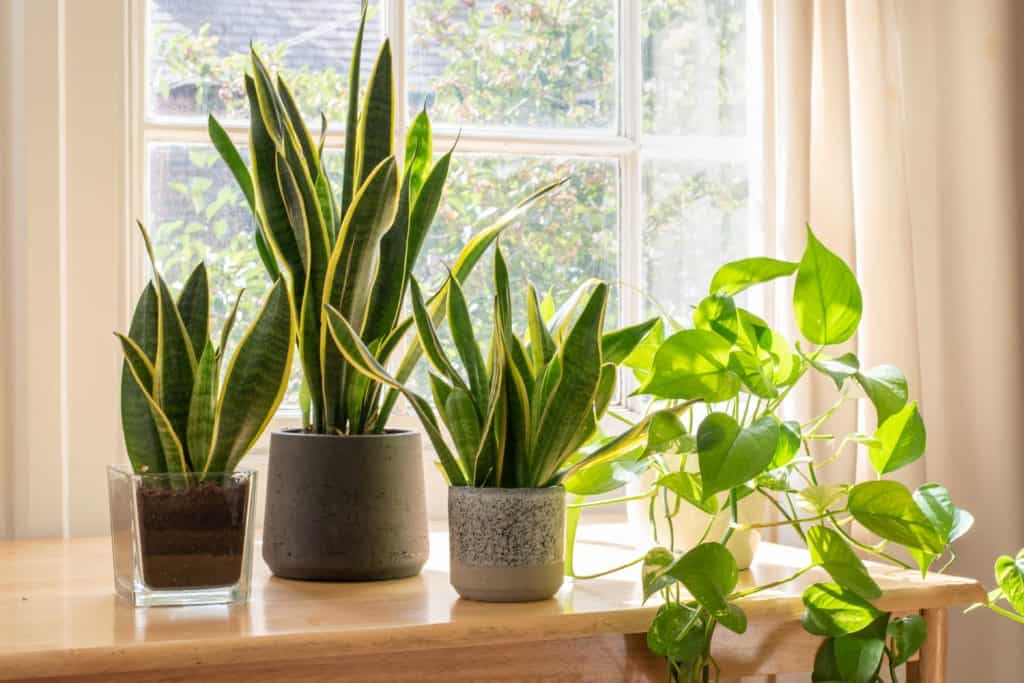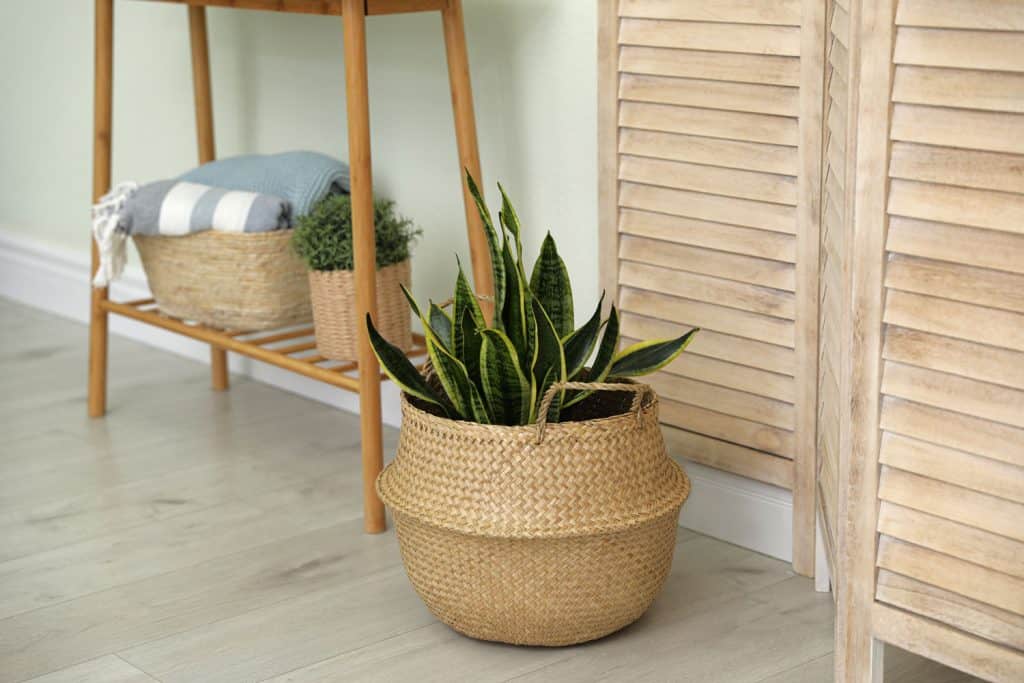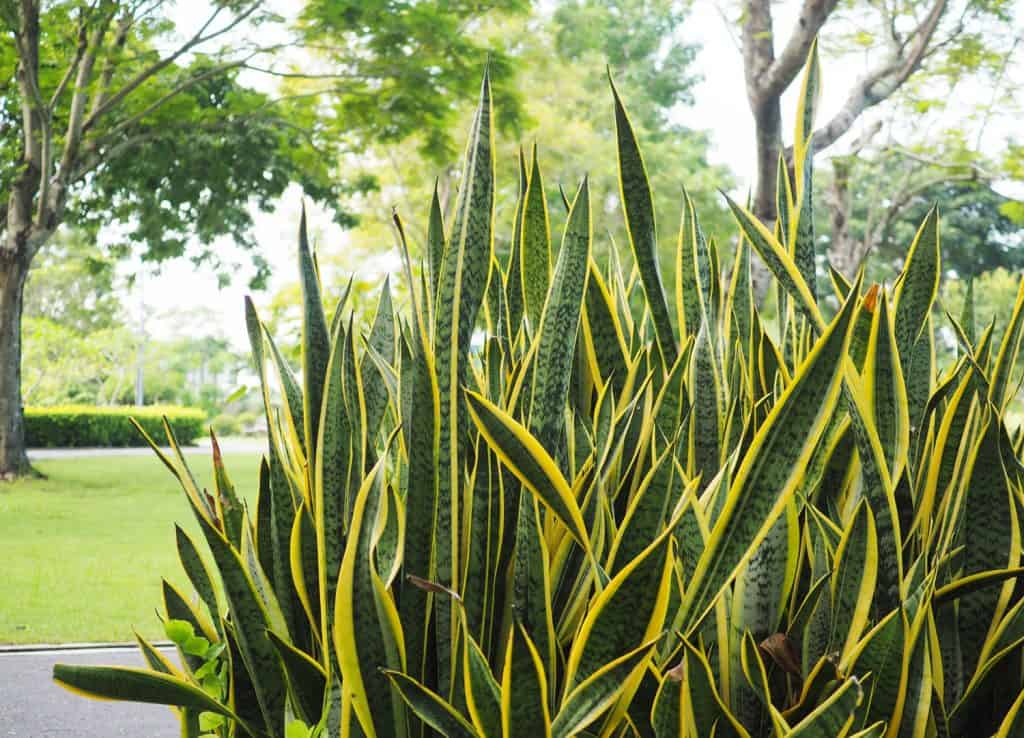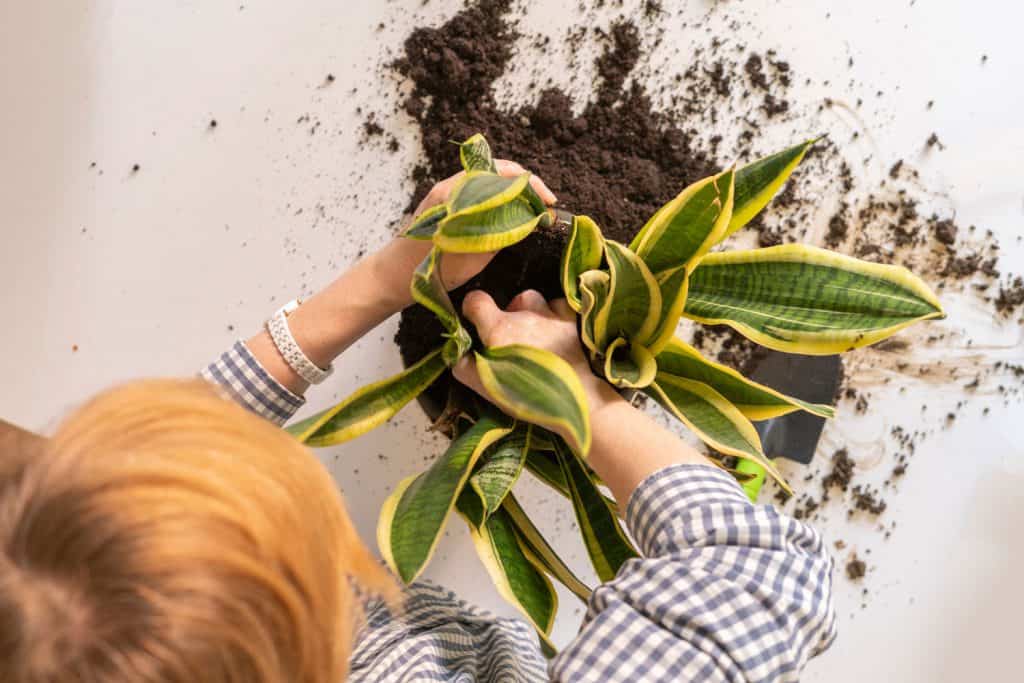Your home's air quality is vital to your health. Poor indoor air quality can cause detrimental health effects like asthma. In contrast, good indoor air quality results in health benefits like easier breathing. Many plants, including Sansevieria [snake plant], improve air quality. If you have a snake plant, you may be wondering if it purifies the air.
Snake plant does purify the air. The plant uses its leaves to remove chemicals from the air. After removing the substances, it produces oxygen, which purifies the air. Some of the chemicals that snake plant removes from the air include formaldehyde, xylene, and toluene.
There are still many things that you might want to know about the snake plant. For example, how long does a snake plant take to purify the air? Which variety of snake plant is best for air purification? What are the benefits of snake plants? We elaborate on these questions and more in this post, so please keep reading!
![Sansevieria plants in pots on table, Does Sansevieria [Snake Plant] Purify Air?](https://gardentabs.com/wp-content/uploads/2021/12/Does-Sansevieria-Snake-Plant-Purify-Air--683x1024.png)
How Long Does a Snake Plant Take to Purify the Air?
A NASA study found that one species of snake plant, Mother-in-Law Tongue, removed 52.6 percent of pollutants from the air in 24 hours. Judging from this study, it can be inferred that snake plants remove all pollutants from the air in about 48 hours.
The snake plant's ability to purify the air reasonably quickly makes it an excellent plant for your home. Placing it in a bedroom, in particular, can make it easier for you to breathe and sleep in no time!

Which Variety of Snake Plant is Best for Air Purification?
There is no specific ranking of snake plant varieties from best to worst. However, some snake plant varieties appear to be especially strong air purifiers. Let's discuss some of these snake plant varieties below.
Snake Plant Compacta (Sansevieria trifasciata 'Compacta')
Snake Plant Compacta is a dwarf snake plant that grows about 6 to 10 inches tall. The plant has unique, compressed foliage that is green with yellow edges.
A NASA study highlighted Snake Plant Compacta for its air-purifying abilities, making it one of the best snake plant varieties for air purification. So, this plant is an excellent option for people who want to add a unique beauty to their home and improve their home's air quality.
Variegated Snake Plant (Sansevieria trifasciata 'Laurentii')
Variegated Snake Plant has green, sword-shaped leaves. It's known for removing various pollutants from the air, including formaldehyde, xylene, toluene, and benzene. These pollutants are commonly found in household appliances and products, such as gas stoves, cleaning products, and paints.
Because Variegated Snake Plants absorb several pollutants, they are one of the best snake plants for air purification. This plant is a great option if you want to ensure that your home is safe from common household toxins!
Mother-in-Law Tongue (Sansevieria trifasciata)
Like Snake Plant Compacta, Mother-in-Law Tongue has green leaves with yellow edges. However, this plant is not a dwarf snake plant, as it can grow up to 8 feet tall.
Like Snake Plant Compacta, NASA found Mother-in-Law Tongue to be one of the most efficient snake plants for air purification. As mentioned, the study found that this plant removes over 50 percent of air pollutants in one day. Consider this snake plant variety if you're looking for a plant that quickly removes air pollutants.
Can a Snake Plant Survive in an Air-Conditioned Room?

A snake plant can survive in an air-conditioned room. Some plants die in air-conditioned rooms because cold temperatures freeze their cells. When a plant's cells are frozen, the plant cannot receive water and nutrients, causing it to starve.
Snake plants do not freeze and starve in air-conditioned rooms because they are very versatile. Their versatility allows them to survive in many different environments, including colder ones.
So, you don't have to worry about your snake plant dying in a cooler room. You can even rely on your snake plant to improve the air quality of the room it's in!
What are the Benefits of Snake Plants?

Snake plants come with many benefits. One of snake plants' most significant benefits is air purification. As mentioned, snake plants remove pollutants like formaldehyde, xylene, and toluene, improving air quality. Better air quality results in many health benefits, including improved breathing and sleep quality.
Another unique benefit of snake plants is their ability to convert carbon dioxide to oxygen at night. The majority of plants can only perform this action during the day. Snake plants' ability to produce oxygen at night allows them to purify the air more efficiently.
The versatility of the plants is also a major benefit. Snake plants thrive in indirect light, but they can survive in nearly any type of lighting. In addition, the plants do not need a lot of water, and they won't die in air-conditioned rooms. Snake plants thrive with little to no maintenance!
How Long Does a Snake Plant Live?

Snake plants generally live for 5 to 10 years. However, they can live for more than 25 years if properly cared for. Properly caring for snake plants involves several factors. Some of these factors include sunlight, soil, water, temperature, and fertilizer. Let's discuss these things in more depth below.
Sunlight
Snake plants prefer indirect, steady sunlight, with some occasional direct sunlight. However, you do not need to place snake plants in indirect light for them to survive. As mentioned, snake plants can survive in a variety of lighting situations. They can thrive in dimly light rooms or rooms with more sunlight.
Soil
Snake plants thrive in well-drained soil. These plants also prefer soil with a low peat content. This is because peat can make it difficult for the soil to drain. Sandy soil is a great option for snake plants.
Click here to find this on Amazon.
Water
Snake plants do not require frequent watering. During the summer, you should water your snake plant every two weeks. Watering every two weeks allows the soil to dry between waterings, which protects the plant from overwatering. During the winter, you only have to water snake plants every month.
Be very careful not to overwater snake plants. Doing so can cause root rot, a condition that results in slow growth and the eventual death of plants.
Temperature
Like many succulents, snake plants grow the best in warmer temperatures. However, they can tolerate cooler temperatures as long as it doesn't drop below 50 degrees Fahrenheit. This means that a cool, air-conditioned room poses no threat to a snake plant.
During the winter, you must bring snake plants indoors, as frost can kill them. Place them in a warm room, and only water them once every six weeks.
Fertilizer
A cactus fertilizer or a balanced slow-release fertilizer is suitable for snake plants. If you are going to fertilize snake plants, you should fertilize them in the spring or summer. Do not fertilize the plants during the fall or winter, as these seasons should emphasize rest for the plants, not growth.
Click here to find this on Amazon.
In Closing

Snake plants are beautiful and unique succulents with a beneficial air purifying ability. Some snake plant varieties that are especially good air purifiers include Snake Plant Compacta, Variegated Snake Plant, and Mother-in-Law Tongue.
It is important to remember that snake plants can survive in air-conditioned rooms. In addition, remember the various benefits that snake plants offer, such as improved air quality and easier breathing. Your snake plant can live for 10 or even 25 years with the proper care.
Before you go, check out some of our other posts:


